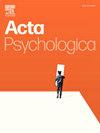用脚和手的作用:一个效应系统支配另一个吗?
IF 2.7
4区 心理学
Q2 PSYCHOLOGY, EXPERIMENTAL
引用次数: 0
摘要
为了有效地行动,必须选择满足性能标准的行动。标准越重要,满足这些标准就越重要。这一观点提出,研究行动选择的目标应该是确定不同绩效标准的相对重要性。为了实现这一目标,我们专注于一个物理动作任务:走到桌子前,用两只手拿起一个盒子,然后在两个位置之间来回移动盒子。在早期的研究中(Ozana et al., 2023),完成这项任务的大学生在到达餐桌时按照自己的意愿站立。研究发现,参与者根据目标之间的距离和需要的来回速度来调整双脚之间的距离,并用节拍器计时。这一结果表明,在这种情况下,手的移动距离和速度优先于脚的分离。在这里报道的两个实验中,我们要求参与者采取宽脚或窄脚的姿势。在实验1中,我们要求脚站宽或脚站窄的参与者,以节拍器指定的高或低的位移率来回移动盒子,覆盖他们想要的任何距离。我们发现自由选择的手移动距离依赖于手移动速率,但几乎不依赖于脚的间距。在实验2中,我们要求新参与者采用宽或窄的脚展,并在两个要求的距离内移动盒子,自由选择盒子移动速度。在这种情况下,我们发现参与者选择的手移动率取决于所需的盒子移动距离,而几乎不取决于脚的距离。我们对先前和当前研究结果的解释表明,在全身物体操作任务中,姿势控制系统施加的约束相对而言不如与手灵巧相关的约束重要。相反,平衡和姿势控制系统似乎是对手动控制系统的敏捷支持。本文章由计算机程序翻译,如有差异,请以英文原文为准。
Acting with the feet and hands: Does one effector system dominate the other?
To act effectively, one must select actions that satisfy performance criteria. The more important the criteria, the more important it is to satisfy them. This idea leads to the suggestion that a goal of research on action selection should be determining the relative importance of different performance criteria. We pursued this aim by focused on a physical action task: walking to a table, picking up a box with two hands, and moving the box back and forth between two positions. In earlier work (Ozana et al., 2023), university students who did this task stood as they wished when they arrived at the table. It was found that participants adjusted the separation between their feet depending on the inter-target distance and required back-and-forth rate, timed with a metronome. This result was taken to suggest that hand-move distance and rate were prioritized over foot separation in this context. In the two experiments reported here, we asked participants to adopt wide or narrow foot stances. In Experiment 1, we asked participants, with wide or narrow foot stances, to move the box back and forth at a high or low displacements rate specified by a metronome, covering whatever distance they wished. We found that the freely chosen hand-move distances depended on the hand-move rate but hardly depended on the foot separation. In Experiment 2, we asked new participants to adopt the wide or narrow foot spread and to move the box over two required distances, freely choosing the box-move rate. In this case, we found that participants chose hand-move rates that depended on the required box-move distance but hardly depended on the foot separation. We interpret the results of both the previous and current study to suggest that constraints imposed by the postural control system are relatively less important than those related to manual dexterity in whole-body object manipulation tasks. Instead, it appears that the balance and postural control system functions as an agile support to the manual control system.
求助全文
通过发布文献求助,成功后即可免费获取论文全文。
去求助
来源期刊

Acta Psychologica
PSYCHOLOGY, EXPERIMENTAL-
CiteScore
3.00
自引率
5.60%
发文量
274
审稿时长
36 weeks
期刊介绍:
Acta Psychologica publishes original articles and extended reviews on selected books in any area of experimental psychology. The focus of the Journal is on empirical studies and evaluative review articles that increase the theoretical understanding of human capabilities.
 求助内容:
求助内容: 应助结果提醒方式:
应助结果提醒方式:


